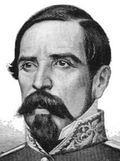 |
Manuel Apolinario José María Ignacio Antonio Lombardini de la Torre
b. 23 Jul 1802, Mexico City
d. 22 Dec 1853, Mexico City |
| Title: |
Depositario del Supremo Poder Ejecutivo de la República Mexicana (Depositary of the Supreme Executive Power of the Mexican Republic) |
| Term: |
7 Feb 1853 - 20 Apr 1853 |
| Chronology: |
7 Feb 1853, elected, meeting of the military commanders designated in Art. 2 of Transitory Provisions to an agreement signed 6 Feb 1853 in Mexico City [1] |
| |
7 Feb 1853, took an oath of office, Mexico City [1][2] |
| |
20 Apr 1853,
ceased to exercise the functions of office upon the installation of a successor [3] |
| Biography: |
| Born in the family of a tax and customs officer at the service of viceroy of New Spain; joined an infantry regiment of Toluca in the Army of the Three Guarantees as a cadet (1821); took part in the siege of Mexico City (1821); left military service in 1822; enlisted in local militia as second lieutenant (1826); belonged to the Masonic Rite of York (yorkinos) and participated in the Battle of Tulancingo (1828) against the rivals of the Scottish Rite (escoceses); married (20 Jan 1830) Mariana Carranza Casaval, a sister of the wife of Gabriel Valencia, becoming his closest ally and "hermano político" in the words of Carlos María de Bustamante; promoted to lieutenant (1830); supported the rebellion initiated by the Plan of Veracruz and showed up with his soldiers to join the army of general Ignacio Ínclan (1832); rallied to support Valencia following his pronunciamiento of Huachinango (4 Sep 1832); promoted to captain (capitan de veteranos) in 1832; participated in the capture of Lerma and Toluca and the siege of Mexico in 1832; won a promotion to colonel from Antonio López de Santa Anna; allegedly signed a petition in favour of the demands of Mariano Arista, calling for defence of the privileges of the army (1833) against the liberal government of Valentín Gómez Farías; was stripped of his rank and dismissed from military service (1833); after the return of Santa Anna and establishment of autocratic rule, he was restored to military service (1834) and made primer ayudante of the battalion of Toluca; marched to Puebla in a campaign to crush the defenders of state rights; distinguished himself during the siege of this city (1834) and was brevetted colonel; commanded an infantry battalion during the war in Texas (1836); fought against the French invasion of Mexico (1838-1839); on orders of Valencia, he arrived to the Ciudadela, a fortress in Mexico City, and led an assault on the National Palace held by the rebels under general José Urrea and Gómez Farías (15 Jul 1840); was confirmed in rank of colonel and then brevetted brigadier general (1840); adhered to another pronunciamiento of Valencia (4 Sep 1841) against President Anastasio Bustamante; was a signatory to the Bases de Tacubaya (28 Sep 1841), which sanctioned the presidency of López de Santa Anna; promoted to brigadier general (1841); participated in the Mexican–American War and was wounded in the Battle of Buena Vista (23 Feb 1847); appointed commandant-general of the Federal District (1847); assumed command of the Army of the East (1847); oversaw the retreat of Mexican army from the capital (1847); ratified truce agreement with the United States (1848); commandant-general of Puebla (1849); served as chief of staff of the Mexican army (1849-1853); signed a proclamation of the garrison of Mexico City (20 Jan 1853), adhering to the Plan of Guadalajara (Plan del Hospicio, 20 Oct 1852) aimed at establishing the dictatorship of López de Santa Anna; assumed command of the division of Mexico City (21 Jan 1853); entered into agreement with other leaders of the revolution, general José López Uraga and lieutenant colonel Manuel Robles Pezuela (6 Feb 1853), to implement the provisions of the Plan of Guadalajara; elected provisional head of state (Depositario del Supremo Poder Ejecutivo) following the resignation of Interim President Juan Bautista Ceballos (7 Feb 1853); supervised the transition to a new regime under Santa Anna who was installed as President of the Republic on 20 Apr 1853; was promoted to divisional general, appointed councillor of state and commandant-general of the State and District of Mexico (1853). |
| Biographical sources: birth and baptismal record in Archivo de la Parroquia del Sagrario Metropolitano de Mexico, Bautismos de españoles 1799-1803, fol. 103; obituary: El Universal, No. 145, 23 Dec 1853, p. 3. |
| Elections: |
| Candidate |
Votes (7 Feb 1853) |
| Manuel Apolinario José María Ignacio Antonio Lombardini de la Torre |
2 |
| Teodosio Lares |
1 |
|
| Source of electoral results: El Siglo Diez y Nueve, No. 1,503, 9 Feb 1853, p. 4. |
| |
| [1] |
El Siglo Diez y Nueve, No. 1,503, 9 Feb 1853, p. 4. |
| [2] |
A circular of the ministry of internal and external relations dated 7 Feb 1853 plainly stated that Lombardini took an oath prescribed by Art. 5 of an agreement signed in Mexico City 6 Feb 1853 immediately after his election (El Siglo Diez y Nueve, No. 1,503, 9 Feb 1853, p. 4). |
| [3] |
El Universal, No. 370, 21 Apr 1853, p. 3; El Siglo Diez y Nueve, No. 1572, 20 Apr 1853, p. 4. |